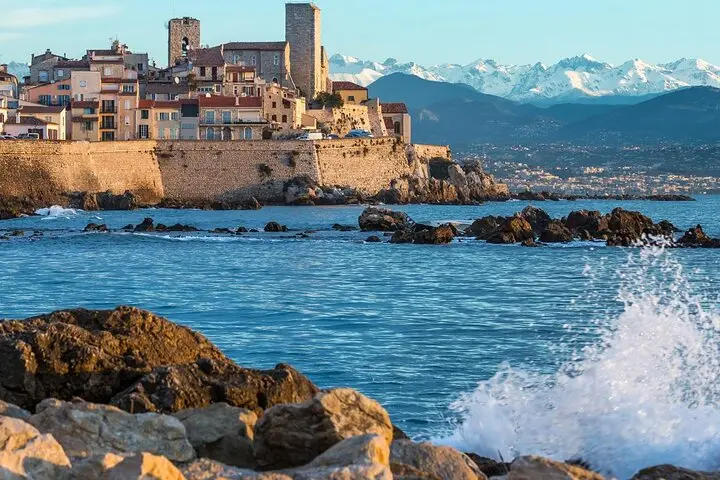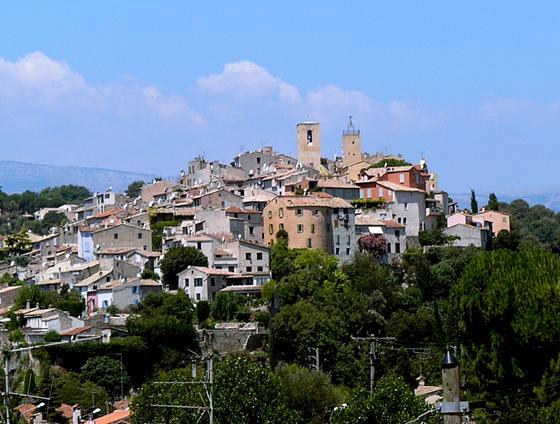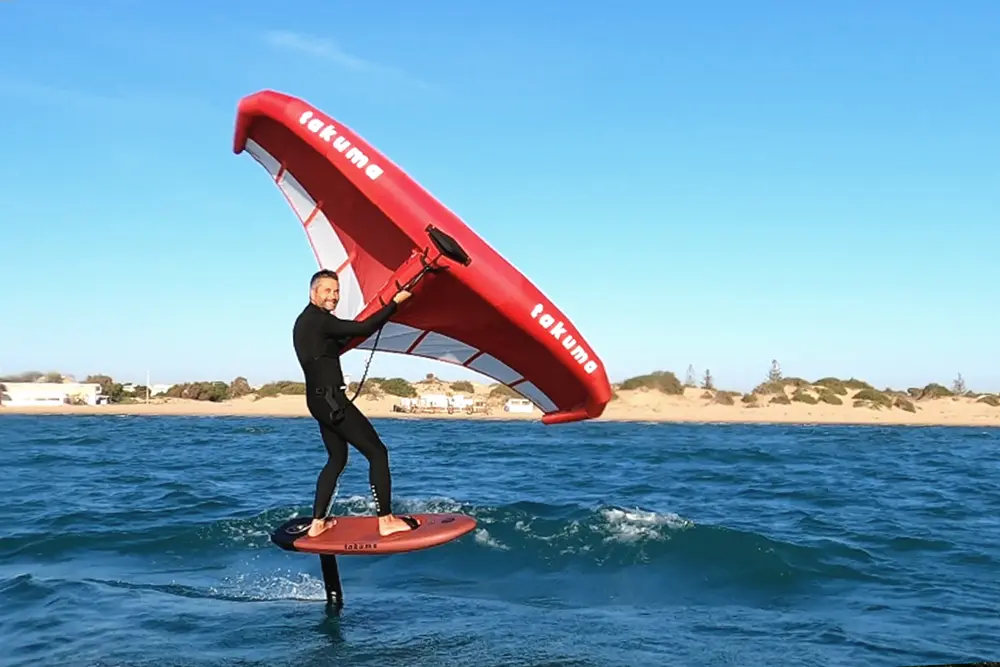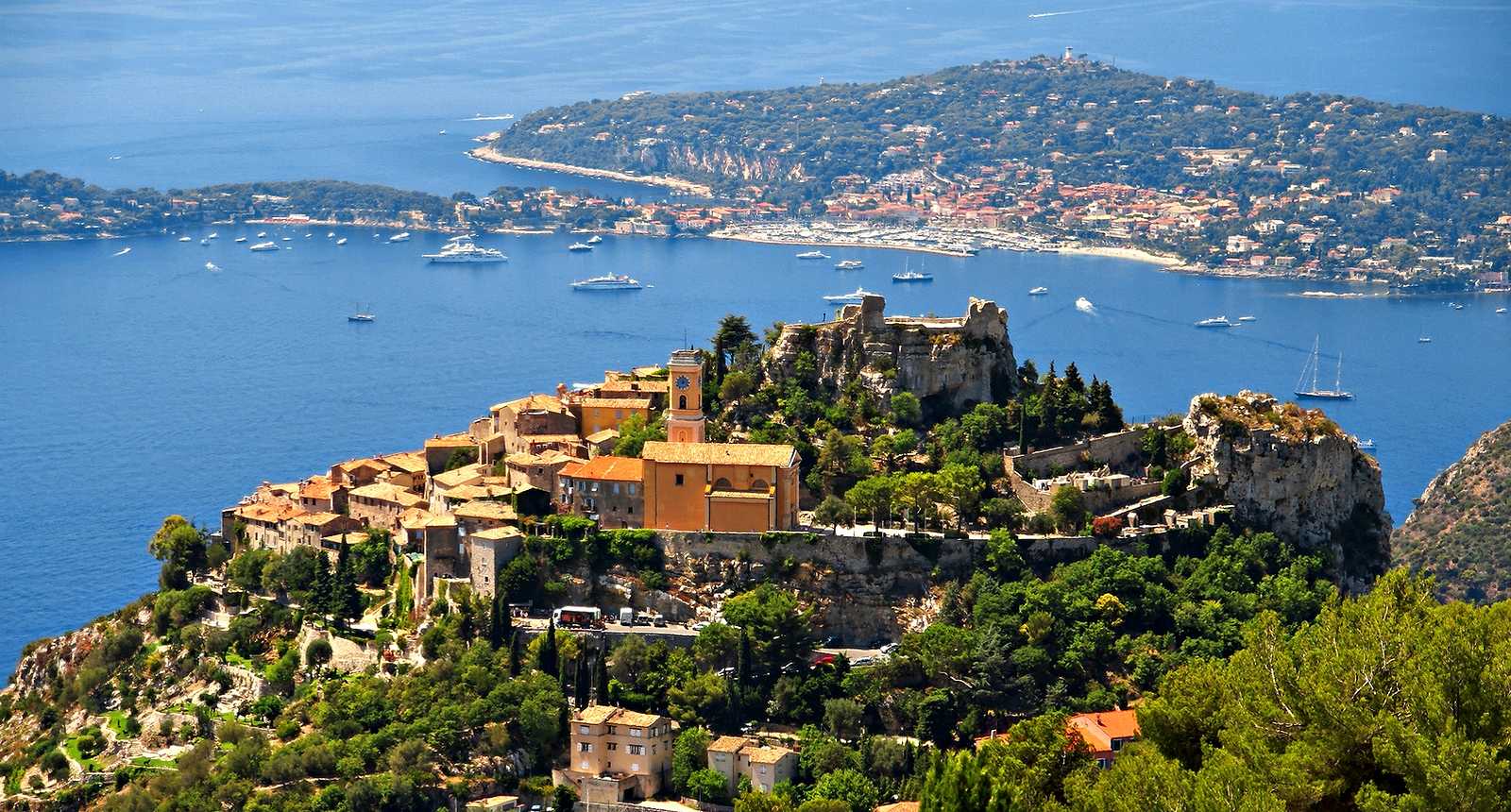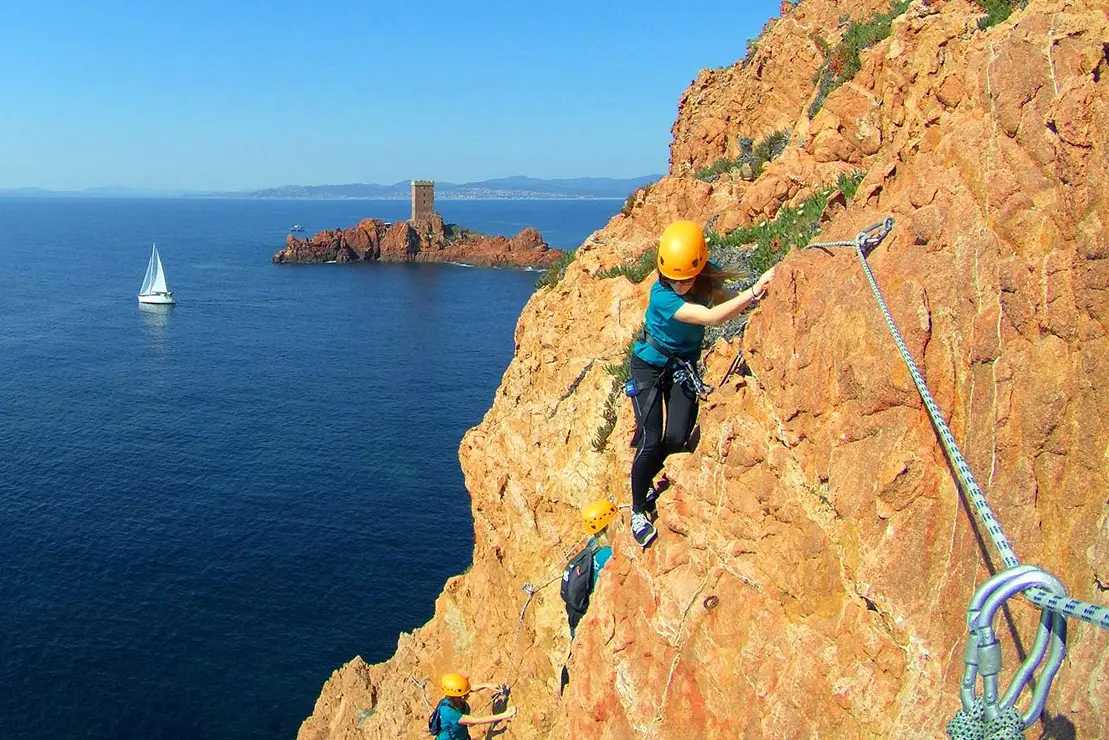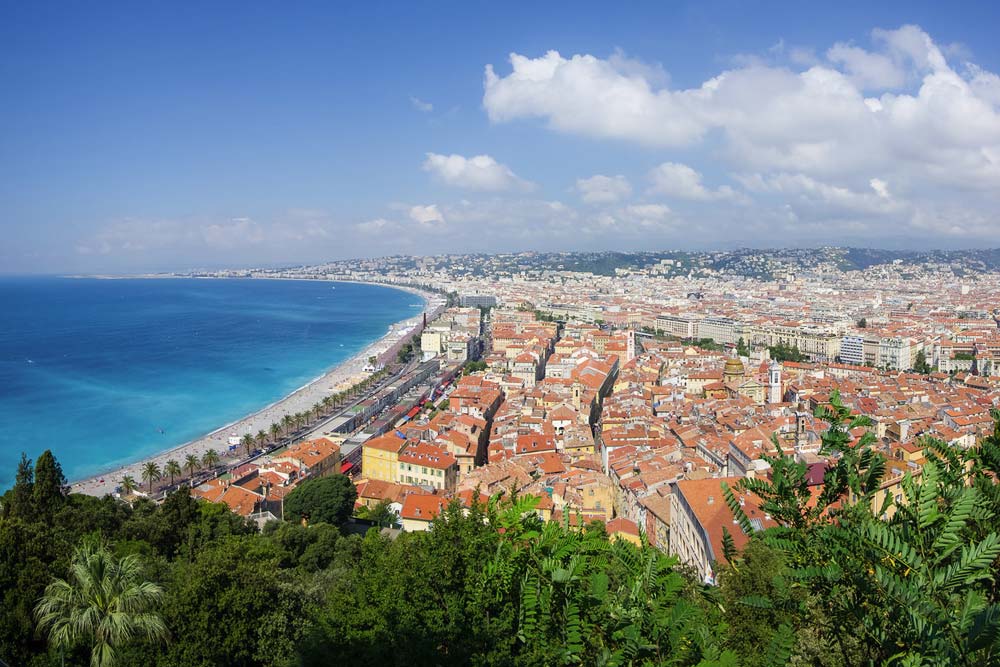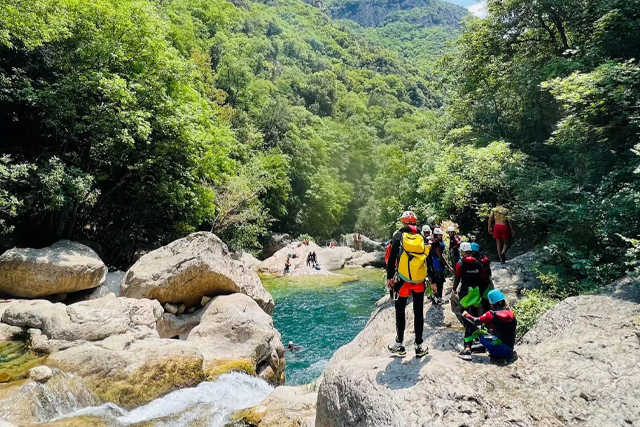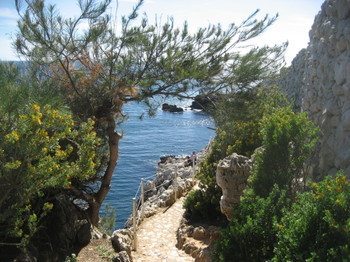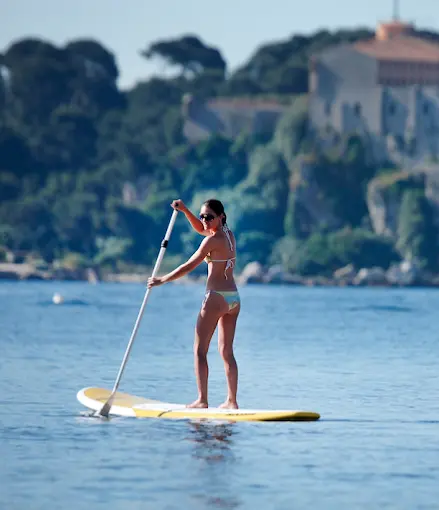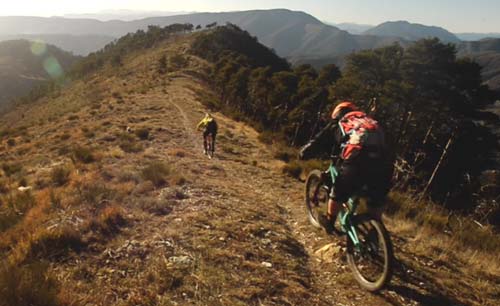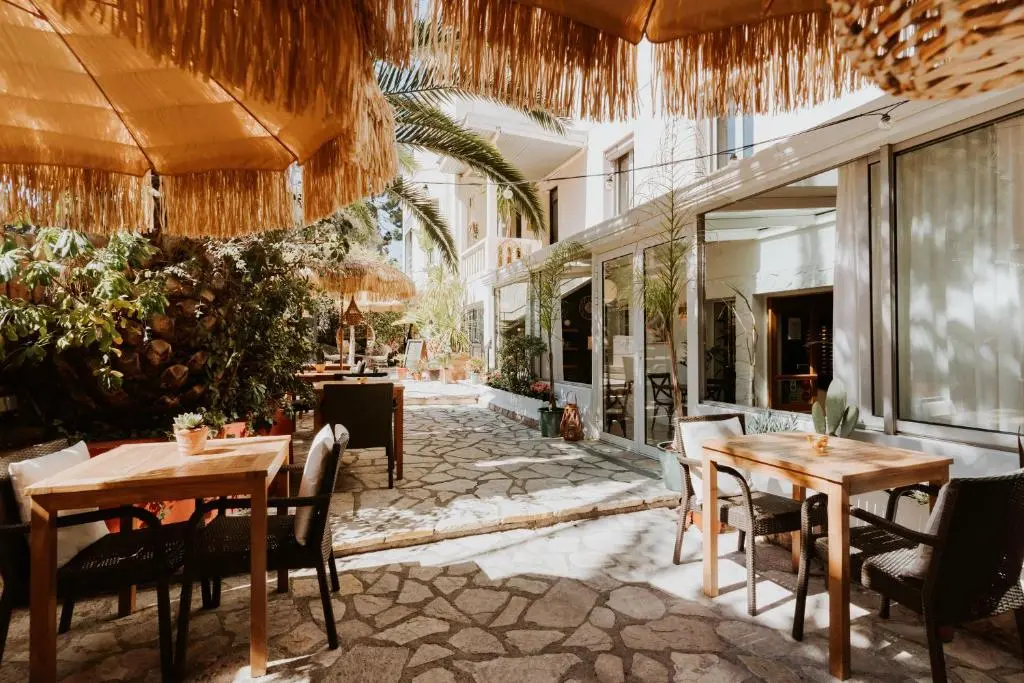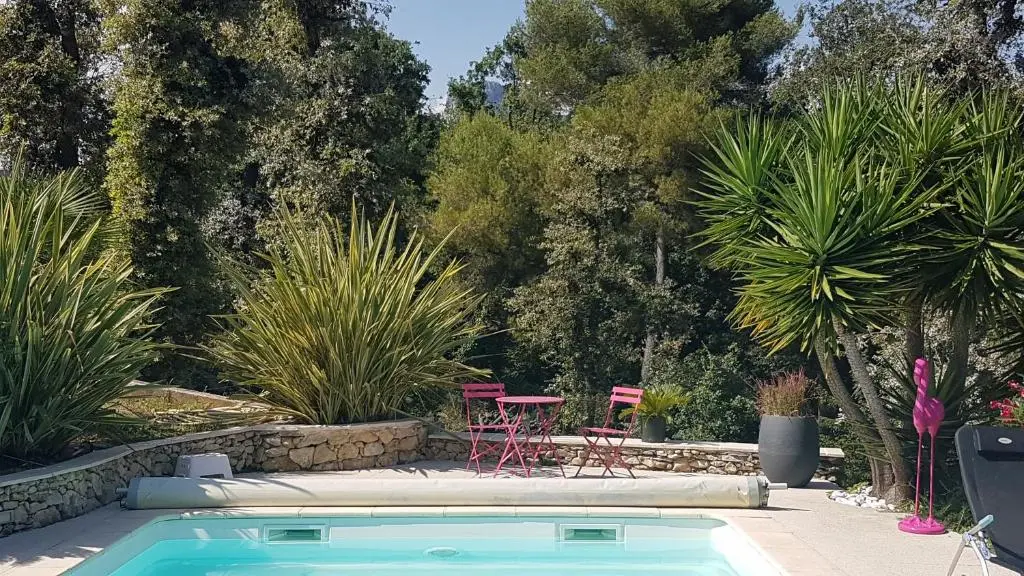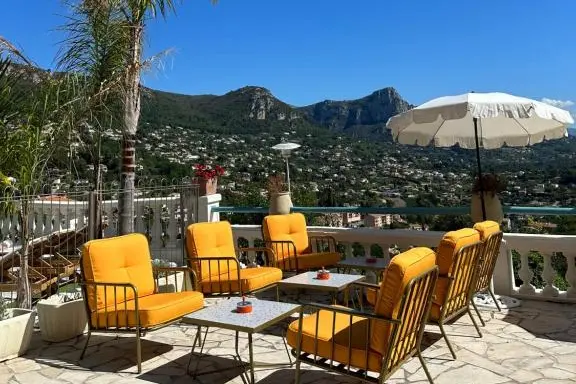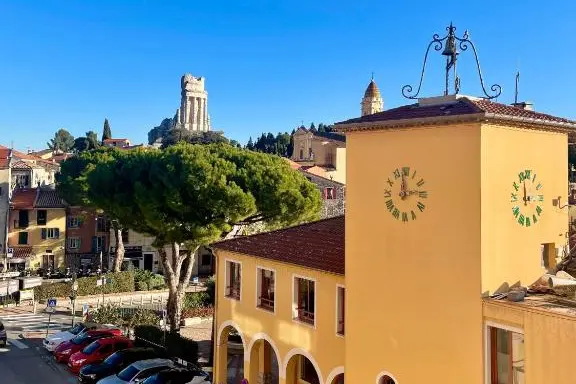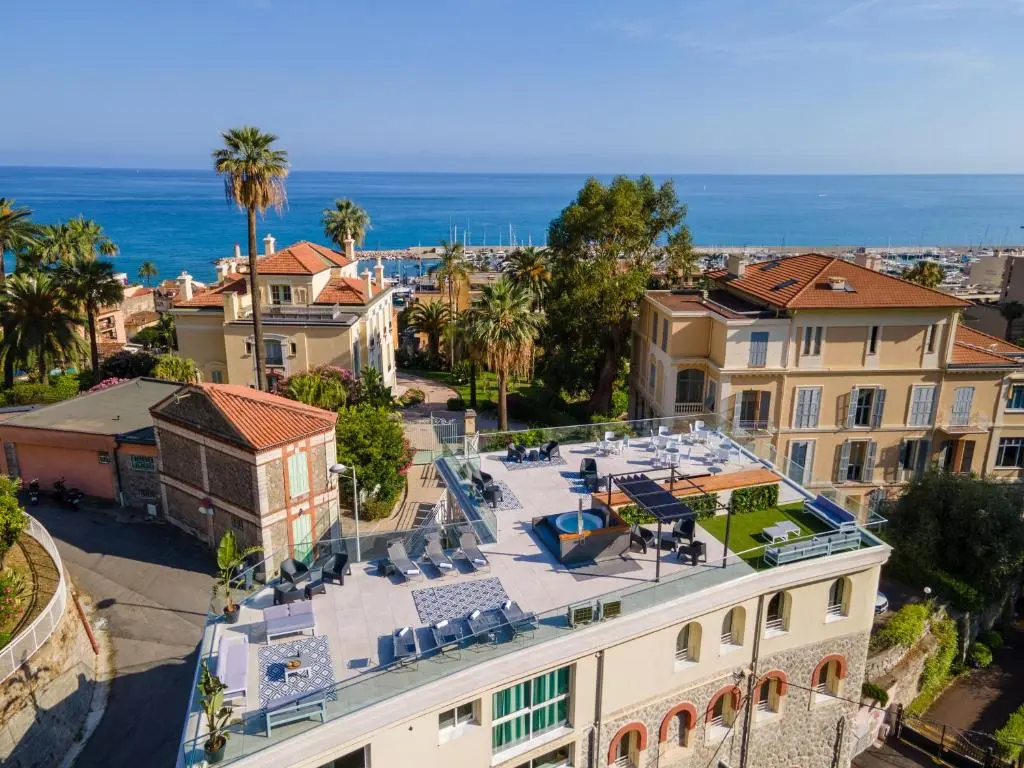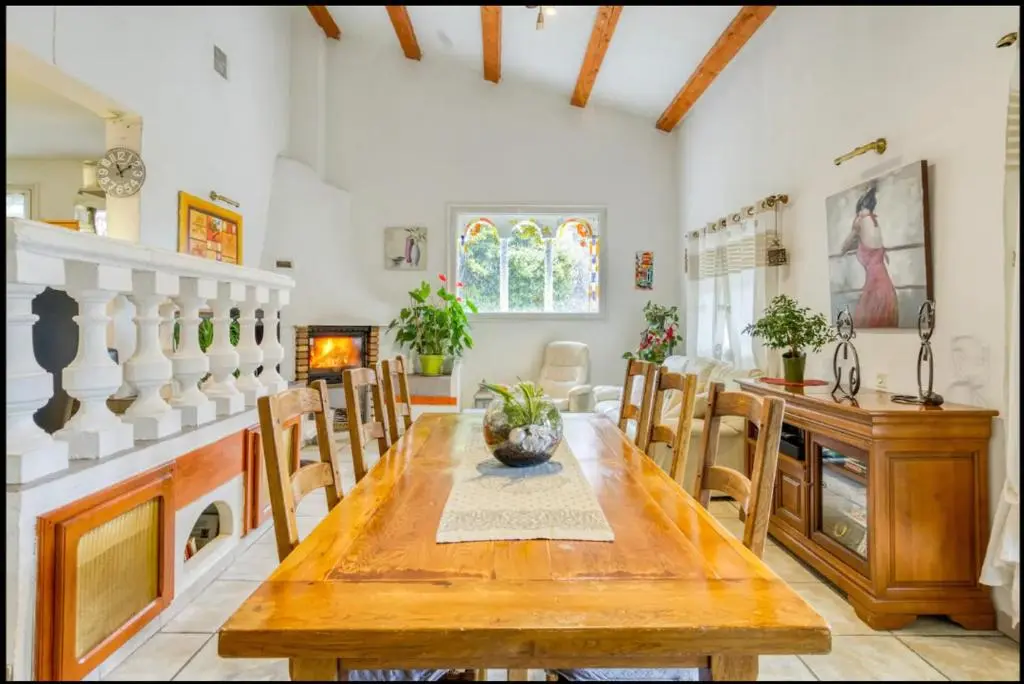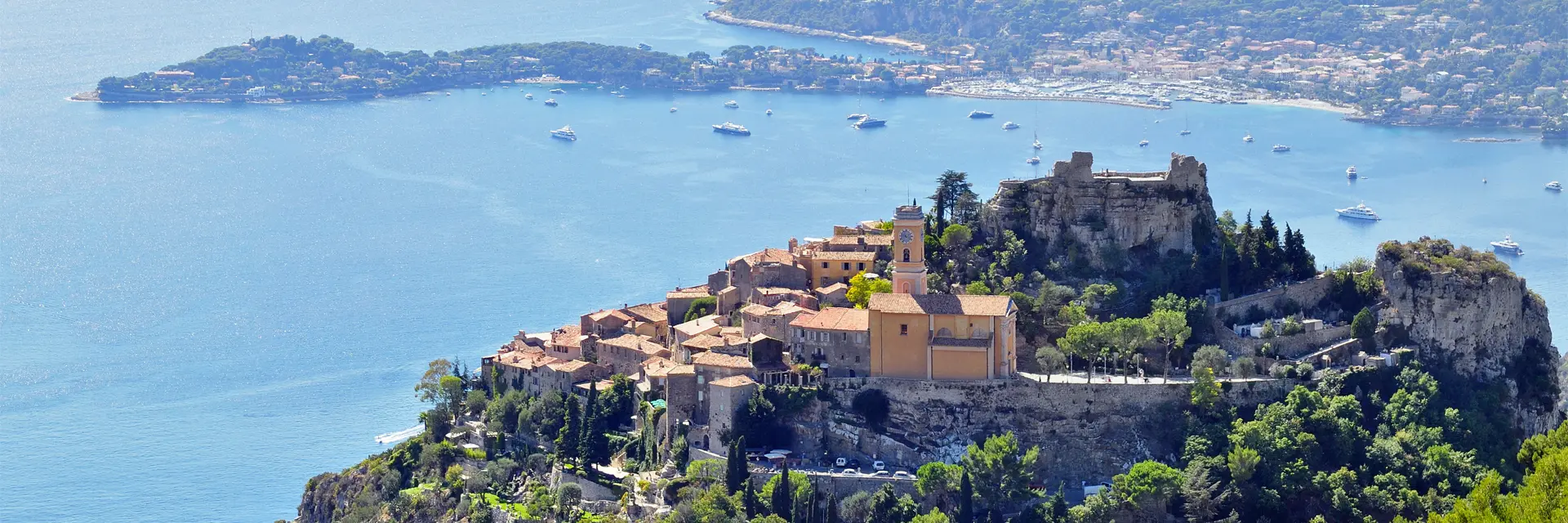
Stretching from the Italian border at Menton to the glitzy and sun-soaked shores of Saint-Tropez, the Côte d’Azur is where the Alps meet the Mediterranean, creating a paradise for outdoor sports enthusiasts. With its dazzling coastline, rugged cliffs, and wild hinterland, complete with bone dry hiking and biking trails, the French Riviera is the perfect playground for adventure seekers.
PLACES TO VISIT | ACTIVITIES | ACCOMMODATION | PRACTICAL INFO
Kitesurf, sail and eFoil in the turquoise waters of the Mediterranean. Paddleboard along the Cap d’Antibes, dive into shipwrecks off Saint-Raphaël, or cliff-jump into the calanques near Cassis. Inland, discover a world of untamed beauty—hike the stunning trails of the Mercantour National Park, canyon through the dramatic Gorges du Loup, or climb the limestone cliffs of La Turbie and Saint-Jeannet.
From the chic harbours of Nice and Cannes to the hidden wilderness of the Esterel Massif, the Côte d’Azur is a place where adventure meets elegance. Whether you’re carving through waves, scaling cliffs, or exploring mountain trails, this legendary coastline delivers high-energy thrills against an iconic Mediterranean backdrop.
Explore the French Riviera
The Côte d’Azur is a paradise for outdoor enthusiasts, offering sun, sea and mountains, and year-round adventure. Whether you’re into hiking or biking the dry trails, free-climbing the sea cliffs, or paddleboarding the sparkling coastline, there’s something for everyone in this south-east corner of France.
Here’s a list of our favourite places to visit from Saint Tropez to Menton:
1. Antibes
Sandwiched between Cannes and Nice, Antibes is a fantastic base for both water sports and land-based activities. Carve up the bay on an eFoil at Cap d’Antibes, paddleboard along the stunning coastline, or dive into crystal-clear waters teeming with marine life. Climbers will find deep water soloing spots around La Baie des Milliardaires on Cap d’Antibes. On land, hit the mountain bike trails just inland, or hike the rugged Sentier du Littoral. For the ultimate thrill, try canyoning in the Gorges du Loup a short drive away. Whether on water or land, Antibes delivers high-energy adventure with unbeatable Riviera views.
2. Biot
Biot is a charming hilltop village just 20km from Nice, offering a perfect mix of history, art, and outdoor adventure. While its cobbled streets and Provencal markets are worth exploring, the real draw for outdoor enthusiasts is the Biot to Valbonne hike. This scenic trail winds through lush Mediterranean forests and rolling hills, connecting two of the Riviera’s most picturesque villages.
For a more relaxed experience, enjoy a picnic in the shaded Jardin Frédéric Mistral park or visit Biot’s renowned glass factory to watch artisans at work. Whether you’re hiking, strolling, or simply soaking up the views, Biot is a great spot to escape the coastal crowds and experience the Cote d’Azur’s rugged interior.
3. Cagnes-sur-Mer
Cagnes-sur-Mer, nestled between Nice and Antibes, is a prime spot for outdoor adventure on the Côte d’Azur. Its calm waters and scenic coastline make it perfect for stand-up paddleboarding, kayaking, and swimming, with warm Mediterranean temperatures year-round. Beyond the beach, cycle the seafront promenade or hike up to Haut-de-Cagnes for stunning coastal views. For a change of pace, explore the Parc des Rives du Loup, a beautiful riverside trail connecting Cagnes with Villeneuve-Loubet. Whether gliding on the sea or exploring inland, Cagnes-sur-Mer offers the perfect mix of watersports and outdoor escapes.
4. Cannes
Cannes, renowned for its glamorous film festival, also offers a ton of outdoor activities. The city’s Mediterranean setting, just 30 minutes from Nice and backed by mountains, makes it a great destination for an active holiday.
For water sports, Palm Beach is good for wingfoiling and kitesurfing, while the Plages du Midi and Plages de la Bocca (west of the old port), offer excellent swimming and paddleboarding. And, the iconic Boulevard de la Croisette provides a scenic route to cycle, rollerblade, or stroll.
Inland, the hills behind Cannes are criss-crossed with hiking and biking trails. Venture further into the hills for paragliding and canyoning.
5. Èze
The ancient village of Èze, with its stunning views over St Jean-Cap Ferrat, is a must-visit if you’re driving the legendary Grande Corniche. Perched on a rocky peak at an altitude of 427m overlooking the Mediterranean sea, the village is centred around the ruins of a 12th century castle.
Hike the Nietzsche trail down to the sea, or paraglide from Mont Bastide down to Eze beach, where sailing, diving and sea kayaking are all popular.
6. Massif de l’Estérel
The Massif de l’Estérel is an adventure playground where flame-red volcanic rocks meet the Mediterranean’s azure waters. This striking terrain between Cannes and Saint-Raphaël delivers 100km+ of epic trails perfect for mountain biking and hiking.
Thrill-seekers can take on the Via Cordata at Cap Dramont, bike the dry trails, or paddleboard into hidden coves. The contrast is wild – red rocks against turquoise waters, and vivid green Aleppo pines against a Riviera blue sky, make for Instagram gold. Go in spring for a wildflower display or autumn for warm water and fewer visitors.
7. Nice
City by the sea, but with a backdrop of mountains, the nearest ski resorts are just over an hour away. Close to the border with Italy, Nice is a bit Italian, a bit French, yet has a vibrant culture all of its own.
If you like the buzz of a city, with bars, restaurants, nightlife and transport links, Nice is a fantastic place to base yourself for an active holiday in the south of France.
Activities on the Côte d’Azur
The Côte d’Azur isn’t just about lounging on the beach and lapping up the Riviera glitz and glamour – it’s also about working up a sweat out in the wilds. From the azure water of the Mediterranean to the rugged Alpine foothills that rise up behind the coast, this region offers a crazy range of outdoor activities that you can do year-round. Whether you want to jump and slide down limestone canyons, paddle board round a stunning peninsula, or climb, bike and hike the steep, dry trails of the hinterland, the French Riviera has fun things to do in spades.
Here are some of our favourite things to do on the Côte d’Azur:
Canyoning
Hiking
Paddle Boarding
Mountain Biking
Rock Climbing
Via Ferrata
Tandem Paragliding
Experience the thrill of tandem paragliding in Gréolières, a mountain resort just 30 kilometres from the glamorous beaches of the French Riviera.
Soar above the wild, unspoilt Loup Valley with an experienced instructor who’ll expertly handle all the technical aspects. You just need to buckle up and enjoy the thrill of the flight, and the breathtaking panoramic views of the mountains and the coastline of the Côte d’Azur in the distance.
Accessible to everyone from age 4, this 15 minute flight requires no previous experience—just a sense of adventure.
A tandem paragliding flight in Gréolières is a must-do activity for thrill-seekers visiting the South of France.
Accommodation on the Côte d’Azur
The French Riviera offers lots of accommodation options in top locations for outdoor sports enthusiasts. When selecting your base, don’t just think about comfort and amenities, but also consider the proximity to your preferred activity. We’ve picked out some of the best mid-range accommodation that caters specifically to active travellers, with locations that minimise travel time to hiking trails, climbing routes, water sports centres, and canyoning descents.
Here are some of our favourite places to stay on the Côte d’Azur:
Antibes
Hôtel Le Petit Castel
– Bike storage and maintenance area.
– Partnerships with local sailing and diving schools.
– Quiet garden for post-activity recovery.
– Breakfast served from 6:30am for early risers heading to activities.
Saint-Jeannet
Mikado Apartment
– Views over the iconic Baou de Saint-Jeannet climbing crag.
– Easy access to over 130 climbing routes.
– Outdoor swimming pool with terrace for relaxing after a day’s climbing.
– Free WiFi and free on-site parking.
Vence
Hôtel Miramar
– Panoramic views from pool deck for yoga sessions.
– Energy-focused breakfast items.
– 20 minutes to beaches, 15 minutes to hiking trails.
– Partner discounts with local activity providers.
La Turbie
Hôtel Napoléon
– Storage for wet gear and climbing equipment.
– Early breakfast available for active days out.
– 20 minutes to beaches, 15 minutes to climbing sites.
Menton
Le Vallaya Suites & Spa
– Close to train station and short walk to Menton centre.
– Spa and wellness centre with a hot tub, sauna, and steam room.
– Fitness classes, walking tours, hiking, and cycling are all available.
Gréolières
Villa Regain Chambres d’hôtes
– Year-round activities from paragliding and hiking in summer to skiing in winter.
– Join the hosts for a home-cooked three-course evening meal.
– Free on-site private parking.
Practical Info
The Côte d’Azur, often called the French Riviera, stretches along France’s Mediterranean coast from Toulon to the Italian border. Technically part of Provence, it covers most of the Alpes-Maritimes and Var departments. While towns like Saint-Tropez, Cannes, and Antibes are famed for their glitzy image and celebrity appeal, the region is surprisingly down to earth and an excellent destination for an active holiday.
The Côte d’Azur, often called the French Riviera, stretches along France’s Mediterranean coast from Toulon to the Italian border. Technically part of Provence, it covers most of the Alpes-Maritimes and Var departments. While towns like Saint-Tropez, Cannes, and Antibes are famed for their glitzy image and celebrity appeal, the region is surprisingly down to earth and an excellent destination for an active holiday.
In summer, you can expect warm sea temperatures up to 25°C. There are over 40 km of beaches, and a mix of rugged natural beauty, history, and vibrant culture. Nice is the region’s largest city and a great base, with excellent rail links and accommodation options.
West of Nice, you’ll find Antibes, the luxurious resort of Cannes, and the red rock coastline around the Massif de l’Esterel leading to Saint-Raphaël and Fréjus. Inland, picturesque hill towns like Grasse (famous for perfume), Vence, and Saint-Paul-de-Vence are perfect for exploring.
Heading further west, Saint-Tropez gives way to quieter, wilder coastal stretches near the Îles d’Hyères—a group of islands off the coast from Hyères, including Port-Cros, a designated national park. The port city of Toulon marks the western limit of the Côte d’Azur.
To the east of Nice, the landscape rises sharply as the Alps meet the sea. This section includes dramatic coastal roads known as the Corniches, connecting Nice with Menton and the Italian border. En route lies Monaco, the tiny but world-renowned principality, famous for Monte Carlo and its luxury lifestyle.
Driving tips
Driving along the Côte d’Azur gives you the freedom to explore at your own pace—but it comes with a few caveats. Summer traffic can be heavy, especially near hotspots like Nice, Antibes, Cannes and Saint-Tropez, where covering a few kilometres can take ages. That’s why some of the ultra-rich opt to fly in and out by helicopter. Outside of peak season, however, driving is a pleasant and efficient way to get around.
The A8 autoroute is the fastest route along the coast, running from Aix-en-Provence to the Italian border at Ventimiglia. While it’s not the most scenic option, it bypasses many of the congested coastal towns and offers easy access to major Riviera destinations like Cannes, Nice, and Menton.
Parking
- Town centres often have limited street parking with time restrictions. Look for “Zone Bleue” areas (free short-term parking with a disc—available at local shops or tourist offices).
- Use underground parking garages in cities like Nice, Antibes, or Cannes—they’re secure and centrally located but can be pricey.
- In smaller towns and beach areas, aim for park-and-ride lots or out-of-centre parking, especially in summer.
- Avoid illegal parking—fines are frequent and enforcement is strict.
- Many car parks use automatic payment machines; keep coins or a card handy.
Electric Vehicles (EVs)
- Charging infrastructure is improving but still inconsistent, especially outside major towns.
- Look for public charging stations in car parks, supermarkets (like Carrefour, Intermarché and Leclerc), and near tourist offices.
- Use apps like Chargemap, ABRP or PlugShare to find available stations.
- The A8 autoroute has some fast chargers at rest areas, but plan ahead—stations can be few and far between inland or on scenic routes.
- Hotels and accommodation with EV charging are becoming more common—filter for this feature when booking.
Motorhomes (Camping-cars)
- Wild camping is officially banned along the coast and strictly enforced in popular areas.
- Use designated motorhome areas (aires de camping-car) for overnight stays—many offer basic services like water and waste disposal.
- Inland villages are more motorhome-friendly than coastal towns.
- Booking campsites in advance is recommended in July and August.
Useful resource: campingcar-infos.com lists aires and service points throughout France.
Getting Around by Train
Train travel is one of the easiest and most scenic ways to explore the Côte d’Azur. The regional TER (Transport Express Régional) trains run frequently along the coast, connecting key destinations from Toulon in the west to Ventimiglia (just across the Italian border) in the east.
This coastal line stops at many major towns, including Saint-Raphaël, Cannes, Antibes, Nice, Monaco, and Menton. Travel times are short (e.g. Nice to Cannes in 30 minutes, Nice to Monaco in 25), and trains run roughly every 30–60 minutes during the day. Tickets are affordable and can be purchased online, via the SNCF Connect app, or at station kiosks.
Nice makes an ideal base if you’re relying on public transport. From here, you can easily hop on day trips by train without needing a car.
West of Saint-Raphaël:
Beyond Saint-Raphaël, the train line veers inland, so coastal access becomes more limited. To reach Hyères, Le Lavandou, Bormes-les-Mimosas, and Toulon, you’ll need to switch to regional buses, which are reliable but slower and less frequent. Plan ahead if heading this way, especially outside summer.
Tips:
- Validate paper tickets before boarding at the yellow machines on the platform.
- For digital tickets (via app), validation isn’t necessary—but make sure your phone is charged!
- During July & August, trains can be crowded—aim to travel early in the day.
- Want to head to Italy? TER trains continue to Ventimiglia, where you can connect to the Italian rail network (you need to change trains because believe it or not, the rail gauge is narrower in Italy) to travel on to Sanremo, Finale Ligure or Genoa.
Please leave a comment below if you need specific advice for your trip to the Côte d’Azur, or if you have any recommendations to help us improve this guide. Happy holidays!

